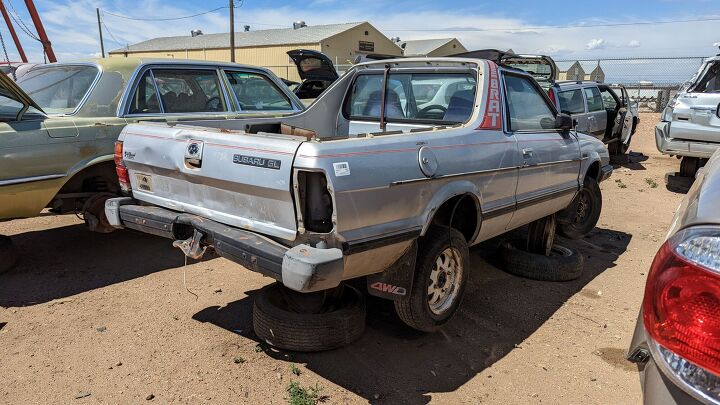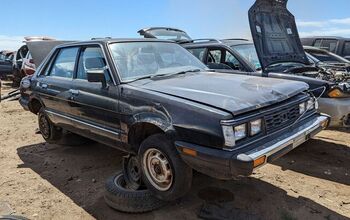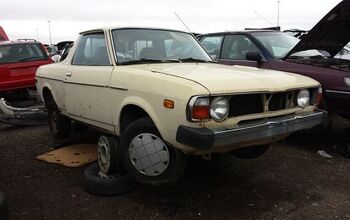Junkyard Find: 1986 Subaru BRAT GL

Subaru sold the Leone in the United States from 1972 through 1994, going through three generations in the process. It was available here in sedan, coupe, hatchback, and wagon form… and as a pickup known as the BRAT. Today's Junkyard Find is a second-generation BRAT, found in a self-service yard between Denver and Cheyenne.
Unlike the other versions of the Leone sold in North America, every BRAT had four-wheel-drive as standard equipment. This made it a sales hit in snowy, mountainous Colorado.
As recently as 10 years ago, I found so many discarded BRATs here that I didn't even bother photographing most of them.
Since that time, examples of the BRAT have become very rare here, in the junkyard or on the street.
Some rusted to death, but most just got used up.
This one was in pretty good condition when its career ended. It isn't rusty and the interior is worn but not horribly abused.
Just a bit over 150,000 miles on the odometer at the end. The highest-mile junkyard Subaru I've documented so far was a 1993 Impreza with 319,554 miles.
This is a high-zoot Brat GL with plenty of nice features and options. US-market Subaru Leone-based car models in 1986 were just called "The Subaru" and so their trim levels became de facto model names here.
In order to evade the 25 percent Chicken Tax on imported light trucks, Subaru installed carpeting and jump seats in the beds of 1978-1985 BRATs sold here. This made them cars in the eyes of federal law. It was one of the more clever methods of Chicken Tax avoidance, but lawsuits resulting from injured back-seat passengers in these "cars" ended up costing Subaru plenty.
1986 was the first model year for the jump seat-free BRAT.
As we can see from the underhood emissions sticker, this is a 49-state (non-California) vehicle and it was categorized as a light truck by the federal government.
At first glance, I thought the shaky-looking graphics were a backyard-applied attempt to imitate the optional factory-applied decals.
However, closer examination shows that 37 years of exposure to the elements simply blew out the edges of the lettering. By the way, BRAT stands for Bi-Drive Recreational All-Terrain Transporter. Not quite as good a tortured Japanese-English acronym as Nissan's PLASMA (Powerful and Economic Light Accurate Silent Mighty Advanced) or Sun Creative System's WOOZ (Wild and Original Object with Zoom), but respectable.
It appears that this truck began its career in Bristol, Pennsylvania, just across the Delaware River from New Jersey.
This oil-change sticker shows that it was still in Pennsylvania in 1993. The lack of rust probably indicates a relocation to the west soon after.
The engine is a 1.8-liter boxer four, rated at 73 horsepower and 94 pound-feet when new.
The transmission is the base four-on-the-floor manual. BRATs were never offered here with five-speed manuals, though a three-speed automatic was an option. I've only found one slushbox-equipped BRAT in all my junkyard travels.
This truck has true four-wheel-drive, with a lever the driver had to yank to switch to front-wheel-drive for use on dry pavement. Subaru began selling vehicles here with what we'd now call all-wheel-drive during the late 1980s; every U.S.-market new Subaru came with AWD starting with the 1996 model year.
This truck has the optional T-top roof, pitched as the "Twin-Halo" roof by Subaru.
It also has the no-extra-cost factory four-speaker AM/FM radio, which was necessary for listening to the top hits of the era in proper fashion.
There's air conditioning, which the 1986 Edmund's Foreign Car Prices book claims was standard equipment in the 1986 BRAT GL (I'm skeptical).
From the front, it looks nearly identical to the GL sedan of a couple of years earlier.
The MSRP for this truck before options was $7,783, or about $21,667 in 2023 dollars.
The final model year for the BRAT in the United States was 1987. Sales elsewhere continued through 1994. Subaru tried to revive the old BRAT magic with the Legacy-based Baja for the 2003-2006 model years, but sales weren't great.
"Just tell 'em it saves ya money, bustah!"
This commercial for the early BRAT emphasizes the fun jump seats.
In Australia and New Zealand, it was known as the Brumby.
[Images: The Author]
Become a TTAC insider. Get the latest news, features, TTAC takes, and everything else that gets to the truth about cars first by subscribing to our newsletter.

Murilee Martin is the pen name of Phil Greden, a writer who has lived in Minnesota, California, Georgia and (now) Colorado. He has toiled at copywriting, technical writing, junkmail writing, fiction writing and now automotive writing. He has owned many terrible vehicles and some good ones. He spends a great deal of time in self-service junkyards. These days, he writes for publications including Autoweek, Autoblog, Hagerty, The Truth About Cars and Capital One.
More by Murilee Martin
Latest Car Reviews
Read moreLatest Product Reviews
Read moreRecent Comments
- Bd2 Lexus is just a higher trim package Toyota. ^^
- Tassos ONLY consider CIvics or Corollas, in their segment. NO DAMNED Hyundais, Kias, Nissans or esp Mitsus. Not even a Pretend-BMW Mazda. They may look cute but they SUCK.I always recommend Corollas to friends of mine who are not auto enthusiasts, even tho I never owed one, and owned a Civic Hatch 5 speed 1992 for 25 years. MANY follow my advice and are VERY happy. ALmost all are women.friends who believe they are auto enthusiasts would not listen to me anyway, and would never buy a Toyota. They are damned fools, on both counts.
- Tassos since Oct 2016 I drive a 2007 E320 Bluetec and since April 2017 also a 2008 E320 Bluetec.Now I am in my summer palace deep in the Eurozone until end October and drive the 2008.Changing the considerable oils (10 quarts synthetic) twice cost me 80 and 70 euros. Same changes in the US on the 2007 cost me $219 at the dealers and $120 at Firestone.Changing the air filter cost 30 Euros, with labor, and there are two such filters (engine and cabin), and changing the fuel filter only 50 euros, while in the US they asked for... $400. You can safely bet I declined and told them what to do with their gold-plated filter. And when I changed it in Europe, I looked at the old one and it was clean as a whistle.A set of Continentals tires, installed etc, 300 EurosI can't remember anything else for the 2008. For the 2007, a brand new set of manual rec'd tires at Discount Tire with free rotations for life used up the $500 allowance the dealer gave me when I bought it (tires only had 5000 miles left on them then)So, as you can see, I spent less than even if I owned a Lexus instead, and probably less than all these poor devils here that brag about their alleged low cost Datsun-Mitsus and Hyundai-Kias.And that's THETRUTHABOUTCARS. My Cars,
- NJRide These are the Q1 Luxury division salesAudi 44,226Acura 30,373BMW 84,475Genesis 14,777Mercedes 66,000Lexus 78,471Infiniti 13,904Volvo 30,000*Tesla (maybe not luxury but relevant): 125,000?Lincoln 24,894Cadillac 35,451So Cadillac is now stuck as a second-tier player with names like Volvo. Even German 3rd wheel Audi is outselling them. Where to gain sales?Surprisingly a decline of Tesla could boost Cadillac EVs. Tesla sort of is now in the old Buick-Mercury upper middle of the market. If lets say the market stays the same, but another 15-20% leave Tesla I could see some going for a Caddy EV or hybrid, but is the division ready to meet them?In terms of the mainstream luxury brands, Lexus is probably a better benchmark than BMW. Lexus is basically doing a modern interpretation of what Cadillac/upscale Olds/Buick used to completely dominate. But Lexus' only downfall is the lack of emotion, something Cadillac at least used to be good at. The Escalade still has far more styling and brand ID than most of Lexus. So match Lexus' quality but out-do them on comfort and styling. Yes a lot of Lexus buyers may be Toyota or import loyal but there are a lot who are former GM buyers who would "come home" for a better product.In fact, that by and large is the Big 3's problem. In the 80s and 90s they would try to win back "import intenders" and this at least slowed the market share erosion. I feel like around 2000 they gave this up and resorted to a ton of gimmicks before the bankruptcies. So they have dropped from 66% to 37% of the market in a quarter century. Sure they have scaled down their presence and for the last 14 years preserved profit. But in the largest, most prosperous market in the world they are not leading. I mean who would think the Koreans could take almost 10% of the market? But they did because they built and structured products people wanted. (I also think the excess reliance on overseas assembly by the Big 3 hurts them vs more import brands building in US). But the domestics should really be at 60% of their home market and the fact that they are not speaks volumes. Cadillac should not be losing 2-1 to Lexus and BMW.
- Tassos Not my favorite Eldorados. Too much cowbell (fins), the gauges look poor for such an expensive car, the interior has too many shiny bits but does not scream "flagship luxury", and the white on red leather or whatever is rather loud for this car, while it might work in a Corvette. But do not despair, a couple more years and the exterior designs (at least) will sober up, the cowbells will be more discreet and the long, low and wide 60s designs are not far away. If only the interiors would be fit for the price point, and especially a few acres of real wood that also looked real.
























































Comments
Join the conversation
I always appreciated the Brat and believe that the time might be right to release a similar type of vehicle on the market. Back then there were a number of vehicles that could fall under the 'ute category including the Dodge Rampage/Plymouth Scamp which were Omni/Horizon derivatives.
I always liked these, though I don’t know how they got those seats in the bed past the feds. Safety considerations aside, the ride in those plastic outboard seats must have been bone-jarring. And I can’t imagine those handles flanking the seats helped much with comfort or safety.
An Impreza-based pickup might do well with outdoorsy types who would like a pick up bed for work or fun but don’t want or need a colossal, expensive truck. It would seat only 2, in the cab, of course.
What’s with that unpleasant troll, anyway.